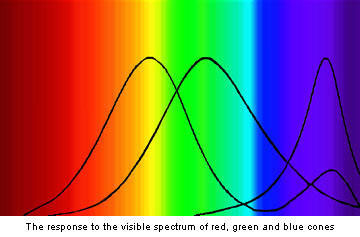
Colour vision is dependent upon receptors in the eye which are sensitive to particular wavelengths of electromagnetic radiation. Many animals have bichromatic vision, or only two different types of receptor, and hence see a limited range of colours rather like those produced by a faulty television. Humans and primates effectively have four types of receptor although two have similar sensitivities and may be treated as part of the same group. Human vision is therefore considered to be trichromatic or three-dimensional. A few people have been found to have what is often known as tetrachromatic vision although experiments have revealed that their perception of colour is not very different from normal. Some animals, however, do have four-dimensional or five-dimensional colour vision which is extremely difficult for human beings to comprehend. Nevertheless, the important point to note is that colour is not an inherent property of an object. It is a property of the nervous system of the animal and eye perceiving the light received from it.
The human experience of colour vision is therefore very personal and subjective, but the basic mechanisms are the same in most cases. Light enters the eye through the lens at the front and is focused onto an internal retina at the back. The retina is covered with millions of light sensitive cells which pass signals to the brain via the optic nerve.
There are two types of light sensitive cells, called rods and cones because of their shape, in an average retina. Each eye has about 120 million rods distributed around the outer edges of the retina. These are mainly sensitive to brightness rather than colour. They are particularly useful to humans for detecting motion and seeing in poor light. The six million cones in each eye are sensitive to colour rather than brightness and are concentrated towards the centre of the retina where more light falls. Each cone contains one of four photo-pigments sensitive to a particular part of the spectrum which produces an electrochemical response when exposed to the relevant wavelength. The responses in the human eye are basically in the long (red and yellow), medium (green) or short (blue) wavelengths. However the spectral bands they detect are wider than their descriptions imply, and overlap each other to a significant extent. Information from the various types of cone is ultimately combined to provide our experience of colour.
The most important aspect of this is that the human eye is sensitive to the red, green and blue wavelengths. Consequently, by presenting different intensities of red, green and blue light, it is possible to obtain the responses achieved by other wavelengths or colours. This principle forms the basis of full-spectrum colour reproduction using only the three primary colours, red, green and blue, in an additive process. The complementary colours, cyan, magenta and yellow, are similarly used in a full-spectrum subtractive processes.
Luminous efficiency, the ability of the eye to detect light, is determined by a combination of the characteristics of the four types of cone and is at a maximum in the yellow area of the spectrum. It is for this reason that yellow sodium street lighting is particularly effective. Photographic emulsions are generally more sensitive in the blue regions. The brain also adapts what the eye detects to a significant extent, and without us realizing what has happened. For example, light from fluorescent tubes or tungsten sources is seen as white despite having characteristic colours. But film does not behave in the same way and consequently may deliver an image quite unlike our recollection of the subject.
Warm colours are central to portraiture because they are the colours of flesh, and tend to convey a message of intimacy and life. We are attracted to these in an image, and consequently describe them as foreground colours. Cool colours such as greens and blues have the opposite effect, perhaps because they are the colours of the more remote forests and oceans. They are variously known as receding or background colours and tend to create an impression of distance and space.






